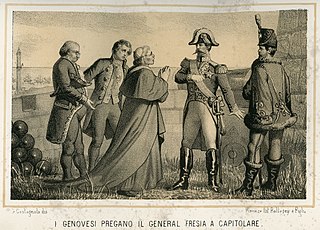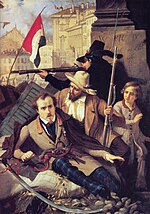
Ferdinand I was King of the Two Sicilies from 1816 until his death. Before that he had been, since 1759, King of Naples as Ferdinand IV and King of Sicily as Ferdinand III. He was deposed twice from the throne of Naples: once by the revolutionary Parthenopean Republic for six months in 1799, and again by a French invasion in 1806, before being restored in 1815 at the end of the Napoleonic Wars.

The Hundred Days, also known as the War of the Seventh Coalition, marked the period between Napoleon's return from eleven months of exile on the island of Elba to Paris on 20 March 1815 and the second restoration of King Louis XVIII on 8 July 1815. This period saw the War of the Seventh Coalition, and includes the Waterloo Campaign and the Neapolitan War as well as several other minor campaigns. The phrase les Cent Jours was first used by the prefect of Paris, Gaspard, comte de Chabrol, in his speech welcoming the king back to Paris on 8 July.

The Kingdom of Naples, also known as the Kingdom of Sicily, was a state that ruled the part of the Italian Peninsula south of the Papal States between 1282 and 1816. It was established by the War of the Sicilian Vespers (1282–1302), when the island of Sicily revolted and was conquered by the Crown of Aragon, becoming a separate kingdom also called the Kingdom of Sicily. This left the Neapolitan mainland under the possession of Charles of Anjou. Later, two competing lines of the Angevin family competed for the Kingdom of Naples in the late 14th century, which resulted in the death of Joanna I by Charles III of Naples. Charles' daughter Joanna II adopted King Alfonso V of Aragon as heir, who would then unite Naples into his Aragonese dominions in 1442.

Joachim Murat was a French military commander and statesman who served during the French Revolutionary Wars and Napoleonic Wars. Under the French Empire he received the military titles of Marshal of the Empire and Admiral of France. He was the first Prince Murat, Grand Duke of Berg from 1806 to 1808, and King of Naples as Joachim-Napoleon from 1808 to 1815.

The Neapolitan War, also known as the Austro-Neapolitan War, was a conflict between the Napoleonic Kingdom of Naples and the Austrian Empire. It started on 15 March 1815, when King Joachim Murat declared war on Austria, and ended on 20 May 1815, with the signing of the Treaty of Casalanza. The war occurred during the Hundred Days between Napoleon's return from exile and before he left Paris to be decisively defeated at the Battle of Waterloo. The war was triggered by a pro-Napoleon uprising in Naples and ended with a decisive Austrian victory at the Battle of Tolentino, after which Bourbon monarch Ferdinand IV was reinstated as King of Naples and Sicily. However, the intervention by Austria caused resentment in Italy, which further spurred on the drive towards Italian unification.

The history of early modern Italy roughly corresponds to the period from the Renaissance to the Congress of Vienna in 1814. The following period was characterized by political and social unrest which then led to the unification of Italy, which culminated in 1861 with the proclamation of the Kingdom of Italy.

The Battle of Tolentino was fought from 2–3 May 1815 near Tolentino, Kingdom of Naples in what is now Marche, Italy: it was the decisive battle in the Neapolitan War, fought by the Napoleonic King of Naples Joachim Murat to keep the throne after the Congress of Vienna. The battle occurred during the Hundred Days following Napoleon's return from exile and, like the Battle of Waterloo, resulted in a decisive victory for the Seventh Coalition, leading to the restoration of the previous Bourbon king, Ferdinand I.

Pellegrino Luigi Odoardo Rossi was an Italian economist, politician and jurist. He was an important figure of the July Monarchy in France, and the minister of justice in the government of the Papal States, under Pope Pius IX.

Carolina Maria Annunziata Bonaparte, better known as Caroline Bonaparte, was an Imperial French princess; the seventh child and third daughter of Carlo Buonaparte and Letizia Ramolino, and a younger sister of Napoleon I of France. She was queen of Naples during the reign of her spouse there, and regent of Naples during his absence four times: in 1812–1813, 1813, 1814, and 1815.
The Battle of Occhiobello was fought on 8 April – 9 April 1815 and was the turning point of the Neapolitan War. Joachim Murat, King of Naples was repulsed by an Austrian force under the command of Johann Frimont whilst trying to cross the bridge over the Po River at Occhiobello. Following the battle, the Austrians would not lose an engagement for the remainder of the war.

Adam Albert, Count von Neipperg was an Austrian general and statesman. He was the son of a diplomat famous for inventing a letter-copying machine, and the grandson of Count Wilhelm Reinhard von Neipperg. His second wife, Empress Marie-Louise, was the widow of Napoleon and a daughter of Francis II, the last Holy Roman Emperor and founding Emperor of the Austrian Empire.

The siege of Ancona took place during the Neapolitan War. It took place beginning on 5 May 1815 and persisted until 30 May 1815. The battle took place mere days after the Battle of Tolentino on 3 May 1815.
The Treaty of Casalanza, which ended the Neapolitan War, was signed on 20 May 1815 between the Napoleonic Kingdom of Naples on the one hand and the Austrian Empire, as well as the Great Britain, on the other. The signature occurred in a patrician villa, owned by the Lanza family, in what is now the commune of Pastorano, Campania, southern Italy.

The Kingdom of Naples was a French client state in southern Italy created in 1806 when the Bourbon Ferdinand IV & III of Naples and Sicily sided with the Third Coalition against Napoleon and was in return ousted from his kingdom by a French invasion. Joseph Bonaparte, elder brother of Napoleon I, was installed in his stead: Joseph conferred the title "Prince of Naples" to be hereditary on his children and grandchildren. When Joseph became King of Spain in 1808, Napoleon appointed his brother-in-law Joachim Murat to take his place. Murat was later deposed by the Congress of Vienna in 1815 after striking at Austria in the Neapolitan War, in which he was decisively defeated at the Battle of Tolentino.

The Army of the Kingdom of Naples was the primary land defence and offence force of the Kingdom of Naples. It served alongside Napoleon’s Grande Armée in various campaigns and wars across Europe, until its final demise in the Neapolitan War of 1815. It was in service from 1806 to 1815, reborn from the Army of the Two Sicilies after the annexation of Naples. The Army was more known for the splendour of its uniforms rather than the achievements of its troops.

The Neapolitan Regiment of Honour Guards was a royal bodyguard unit of the Royal Neapolitan Guard, and was in turn part of the wider Neapolitan Army. The regiment was formed following the succession of Joachim Murat, and would continue to act as the official bodyguard under different designations until its eventual disbandment in 1815 following the disastrous Neapolitan War.

The siege of Genoa on 13–18 April 1814 was the capture of the port city of Genoa from the First French Empire by a British–Sicilian army. It was the last battle of the War of the Sixth Coalition's Italian campaign, as on 4 April, Napoleon had abdicated as emperor of France.
The Treaty of Naples of 11 January 1814 was a treaty that was signed between the Kingdom of Naples and the Austrian Empire.

The Italian Campaign of 1813-1814 was the series of military operations fought during the War of the Sixth Coalition, mainly in northern Italy between the French Empire and the Coalition led by Austrians and British. It represented the last time of the so-called "French period", precisely from the campaign of 1796-1797, in which a French and an Austrian army confronted each other for control of the Italian peninsula. The Austro-Neapolitan War of 1815 was essentially a clash between only Italians and Austrians.

Nunzio Otello Francesco Gioaccino was a soldier and servant during the Napoleonic Wars. Born to an Egyptian family in the Ottoman Empire under Mameluke Occupation, Otello was taken by French officials during their expedition to Egypt in 1798 under general Napoleon Bonaparte. Otello was a gift to Joachim Murat and became his servant when he was 6 years old. He later became an aide and body guard of Murat, and a servant to Caroline Bonaparte, serving as Caroline's personal assistant in the Schloss Frohsdorf estate after her marriage to Francesco MacDonald.



















